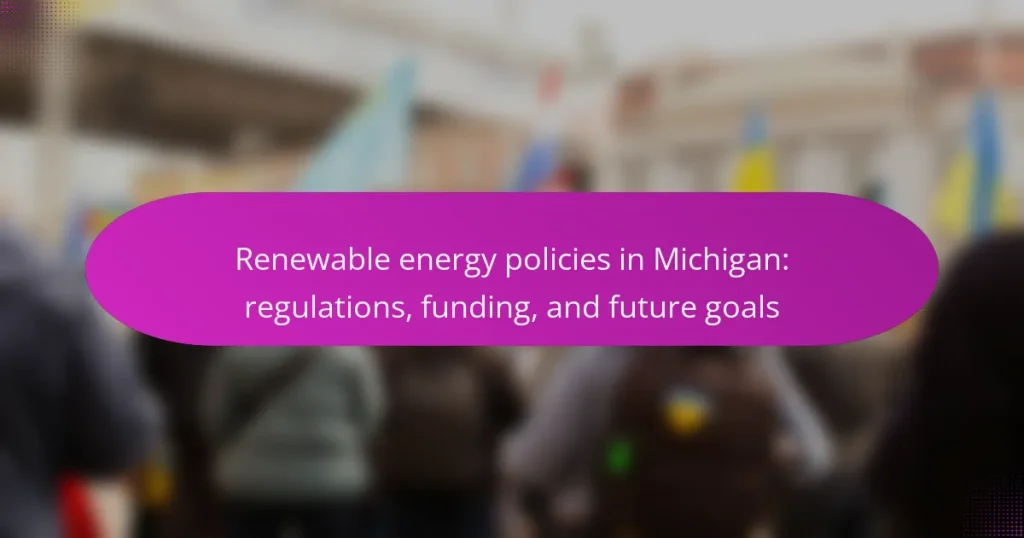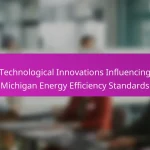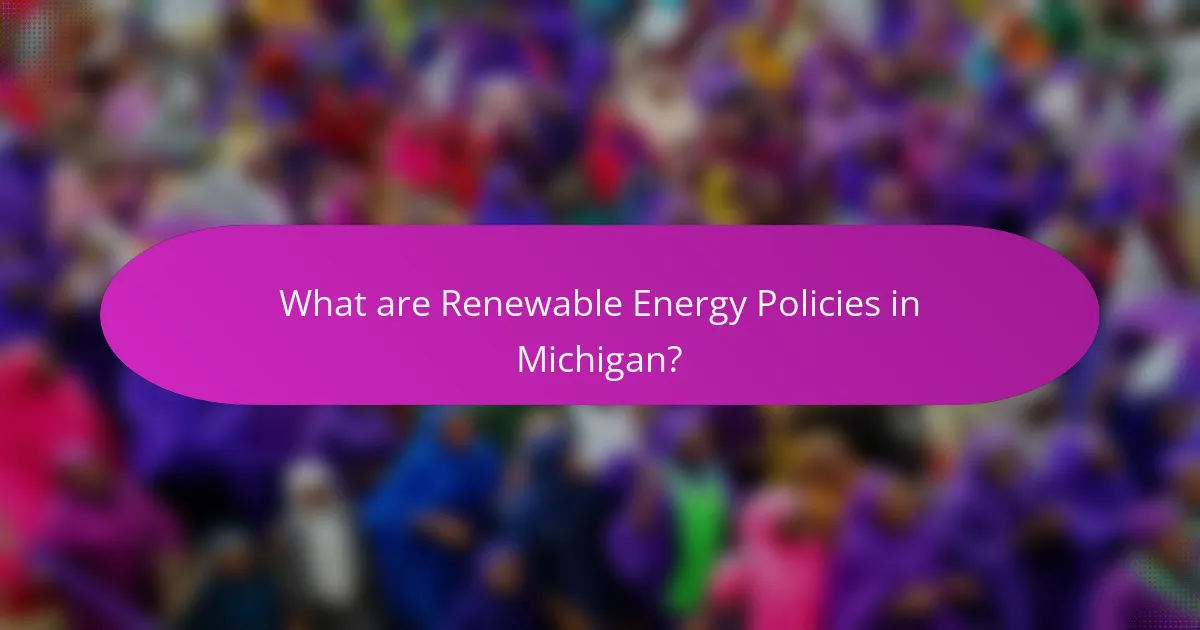
What are Renewable Energy Policies in Michigan?
Renewable energy policies in Michigan focus on promoting clean energy production and reducing reliance on fossil fuels. The state has set a goal for 50% renewable energy by 2030. Key policies include the Renewable Portfolio Standard (RPS) which requires utilities to obtain a certain percentage of their energy from renewable sources. Michigan also offers incentives for solar energy installations and energy efficiency programs. The Clean Energy Plan aims to enhance the state’s energy efficiency and expand renewable energy sources. In 2021, Michigan’s legislature passed a bill to streamline the permitting process for renewable energy projects. These policies reflect Michigan’s commitment to sustainability and environmental protection.
How do these policies impact the state’s energy landscape?
Renewable energy policies significantly reshape Michigan’s energy landscape. These policies promote investment in clean energy sources. They encourage the development of wind, solar, and biomass energy projects. As a result, renewable energy capacity in Michigan has increased by 200% since 2015. The state aims for 50% of its energy to come from renewable sources by 2030. This shift reduces reliance on fossil fuels and lowers greenhouse gas emissions. Additionally, these policies create jobs in the renewable sector. They also stimulate local economies through infrastructure development and technology innovation.
What are the key components of Michigan’s renewable energy policies?
The key components of Michigan’s renewable energy policies include a renewable portfolio standard, incentives for solar and wind energy, and energy efficiency programs. The renewable portfolio standard mandates that 15% of the state’s energy must come from renewable sources by 2021. Additionally, the state offers tax credits and rebates to encourage solar and wind energy installations. Energy efficiency programs aim to reduce overall energy consumption and promote sustainable practices among residents and businesses. These policies are designed to transition Michigan towards a cleaner energy future while supporting economic growth.
How do these policies align with national renewable energy goals?
These policies support national renewable energy goals by promoting clean energy sources. They aim to reduce greenhouse gas emissions in line with federal targets. Michigan’s initiatives prioritize solar and wind energy development. This aligns with the national objective to increase renewable energy’s share in the energy mix. The policies also encourage energy efficiency and conservation practices. Such measures contribute to the overall reduction of fossil fuel dependency. By setting ambitious renewable energy standards, Michigan helps meet national commitments to combat climate change. The state’s actions reflect a broader strategy to transition to a sustainable energy future.
What regulations govern renewable energy in Michigan?
The regulations governing renewable energy in Michigan include the Renewable Portfolio Standard (RPS) and the Clean, Renewable, and Efficient Energy Act. The RPS mandates that utilities obtain a certain percentage of their energy from renewable sources. As of 2021, the target is 15% by 2021, with ongoing discussions for future increases. The Clean, Renewable, and Efficient Energy Act promotes energy efficiency and renewable energy development. Additionally, the Michigan Public Service Commission oversees compliance with these regulations. These regulations are designed to promote clean energy and reduce greenhouse gas emissions in the state.
What are the main regulatory bodies overseeing renewable energy?
The main regulatory bodies overseeing renewable energy in Michigan include the Michigan Public Service Commission (MPSC) and the Michigan Department of Environment, Great Lakes, and Energy (EGLE). The MPSC regulates utility rates and ensures compliance with state energy laws. It plays a crucial role in implementing renewable energy standards. EGLE oversees environmental regulations related to energy projects. It ensures that renewable energy developments meet environmental protection standards. Additionally, the U.S. Department of Energy (DOE) provides federal oversight and funding for renewable energy initiatives. These bodies collectively ensure that Michigan’s renewable energy policies are effectively implemented and regulated.
How do these regulations affect energy producers and consumers?
Regulations on renewable energy in Michigan impact energy producers by mandating renewable energy standards. These standards require producers to generate a certain percentage of energy from renewable sources. This shift can lead to increased operational costs for producers as they adapt to new technologies. However, it can also open opportunities for innovation and investment in cleaner energy solutions.
For consumers, these regulations can lead to increased energy prices in the short term. As producers invest in renewable infrastructure, costs may be passed on to consumers. Over time, consumers may benefit from lower energy bills due to reduced reliance on fossil fuels. Additionally, consumers may gain access to more renewable energy options, enhancing energy choice and sustainability.
The Michigan Public Service Commission reported that renewable energy capacity in Michigan has increased significantly, reflecting the impact of these regulations.
What funding opportunities exist for renewable energy projects in Michigan?
Various funding opportunities exist for renewable energy projects in Michigan. The Michigan Energy Office offers grants through the Renewable Energy Program. These grants support solar, wind, and biomass projects. Additionally, the U.S. Department of Energy provides funding through initiatives like the Solar Energy Technologies Office. The Michigan Public Service Commission also administers the Energy Optimization Program, which incentivizes energy efficiency and renewable energy projects. Furthermore, private investors and venture capital firms are increasingly funding innovative renewable energy startups in the state. Nonprofit organizations, such as the Michigan Environmental Council, also offer resources and funding connections for renewable energy initiatives.
What state and federal programs provide financial support?
State and federal programs that provide financial support for renewable energy include the Michigan Energy Assistance Program and the federal Investment Tax Credit (ITC). The Michigan Energy Assistance Program offers financial aid to low-income households for energy costs. The ITC allows for a tax credit of 30% of the cost of solar energy systems installed on residential and commercial properties. These programs are designed to promote renewable energy adoption and reduce energy costs for consumers.
How can businesses and individuals access these funding opportunities?
Businesses and individuals can access funding opportunities in Michigan through various programs and incentives. The Michigan Energy Office provides resources and information about state and federal funding options. They offer grants, loans, and tax credits specifically for renewable energy projects. Additionally, organizations like the Michigan Economic Development Corporation (MEDC) support funding access for clean energy initiatives. Local utility companies may also have rebate programs for energy efficiency upgrades. Furthermore, federal programs such as the Investment Tax Credit (ITC) and the Production Tax Credit (PTC) provide financial benefits for renewable energy investments. These funding avenues are designed to promote the growth of renewable energy in Michigan.
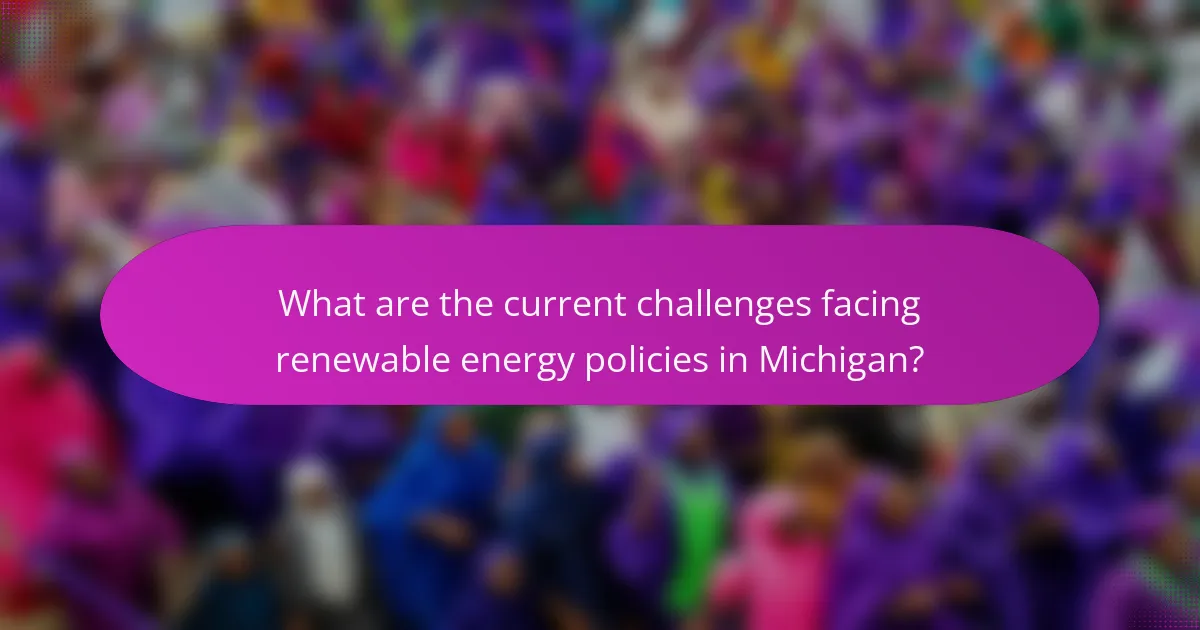
What are the current challenges facing renewable energy policies in Michigan?
Current challenges facing renewable energy policies in Michigan include regulatory hurdles, funding limitations, and infrastructure issues. Regulatory hurdles involve complex permitting processes that delay project implementation. Funding limitations restrict the ability to invest in new technologies and initiatives. Infrastructure issues arise from the need for upgrades to accommodate renewable energy sources. According to the Michigan Public Service Commission, these challenges hinder the state’s transition to cleaner energy. Additionally, stakeholder disagreements complicate policy development and implementation. Overall, these factors impede progress toward Michigan’s renewable energy goals.
How do economic factors influence the implementation of these policies?
Economic factors significantly influence the implementation of renewable energy policies in Michigan. Funding availability directly impacts the ability to develop and deploy renewable energy projects. For instance, limited state budgets can hinder investments in infrastructure and technology. Additionally, economic incentives, such as tax credits and grants, encourage private sector participation. Market demand for renewable energy also affects policy effectiveness. Higher demand can lead to increased investment and innovation in the sector. Conversely, economic downturns may result in reduced funding and slower policy adoption. The cost of renewable technologies, such as solar and wind, plays a critical role in their implementation. As costs decrease, adoption rates typically increase. Overall, economic factors shape the landscape of renewable energy policy execution in Michigan.
What are the barriers to investment in renewable energy?
Barriers to investment in renewable energy include high initial costs, regulatory challenges, and market volatility. High initial costs deter investors due to significant upfront capital requirements. Regulatory challenges arise from complex policies and inconsistent state-level regulations. Market volatility affects the return on investment, making it less attractive. Additionally, limited access to financing can hinder project development. A lack of infrastructure for renewable energy sources further complicates investment opportunities. These barriers collectively slow the transition to renewable energy solutions.
How do public perceptions affect policy development?
Public perceptions significantly influence policy development by shaping the priorities and actions of policymakers. When the public strongly supports renewable energy initiatives, policymakers are more likely to prioritize these issues in legislation. For example, surveys indicate that over 70% of Michiganders support increased investment in renewable energy sources. This public backing can lead to more funding for renewable projects and the establishment of favorable regulations. Conversely, negative public perceptions can hinder progress by creating resistance to proposed policies. In Michigan, community engagement and public opinion have been crucial in shaping the state’s renewable energy goals, reflecting the importance of public sentiment in policy formulation.
What role does technology play in Michigan’s renewable energy future?
Technology is crucial in shaping Michigan’s renewable energy future. It drives advancements in solar, wind, and energy storage systems. Innovations improve efficiency and reduce costs for renewable energy sources. For instance, solar panel efficiency has increased significantly, making solar energy more viable. Wind turbine technology has also evolved, allowing for greater energy capture. Furthermore, smart grid technology enhances energy distribution and management. These technologies enable better integration of renewable sources into the existing grid. Michigan aims to achieve 50% renewable energy by 2030, supported by these technological advancements. The state’s investment in research and development further fosters innovation in the sector.
What innovative technologies are being adopted in the state?
Michigan is adopting innovative technologies in renewable energy. Key technologies include advanced solar panels and wind turbines. These systems are designed for higher efficiency and lower costs. Energy storage solutions, such as lithium-ion batteries, are also being implemented. Smart grid technologies enhance energy management and distribution. Michigan’s commitment to reducing carbon emissions drives these adoptions. The state aims to increase renewable energy to 50% by 2030. This goal aligns with national trends towards sustainable energy sources.
How does technology integration impact policy effectiveness?
Technology integration enhances policy effectiveness by improving data collection and analysis. It enables real-time monitoring of renewable energy systems. This leads to informed decision-making and timely adjustments to policies. For instance, the Michigan Renewable Energy Standard utilizes technology to track energy production and consumption. This data helps policymakers assess the impact of regulations. Additionally, technology facilitates public engagement through transparent communication channels. Engaging stakeholders increases support for renewable energy initiatives. Overall, effective technology integration results in more responsive and adaptive policies.
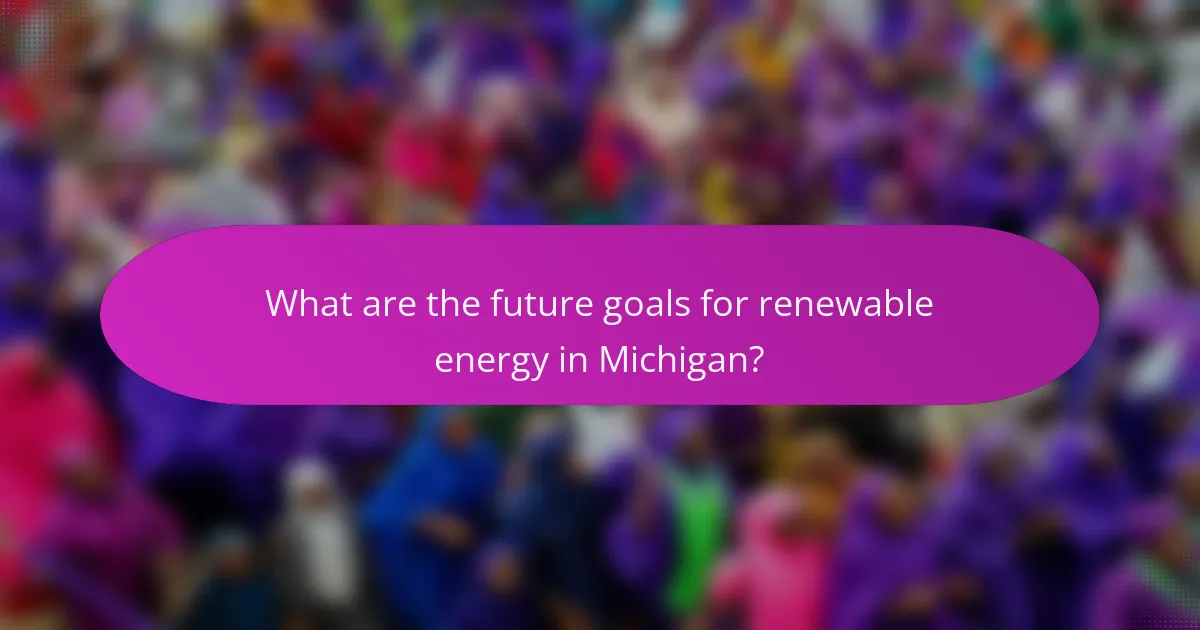
What are the future goals for renewable energy in Michigan?
Michigan aims to achieve 100% carbon neutrality by 2050. The state plans to increase renewable energy sources significantly. By 2025, Michigan targets a 50% reduction in greenhouse gas emissions. The goal includes expanding wind and solar energy capacity. Michigan’s energy plan emphasizes investment in clean energy technologies. The state also seeks to enhance energy efficiency programs. These initiatives are supported by legislation promoting renewable energy growth. Overall, Michigan is committed to transitioning to a sustainable energy future.
What targets has Michigan set for renewable energy adoption?
Michigan has set a target of achieving 50% renewable energy by 2030. This goal is part of the state’s broader commitment to clean energy. The Michigan Public Service Commission has outlined this target in its Integrated Resource Planning process. Additionally, the state aims to reduce greenhouse gas emissions by 28% from 2005 levels by 2025. These targets align with national efforts to transition to cleaner energy sources and combat climate change.
How will these targets impact the state’s energy mix?
The targets will significantly shift Michigan’s energy mix towards renewable sources. Increased reliance on wind and solar energy is expected. By 2025, the state aims for 15% of its energy to come from renewables. This transition will reduce dependence on fossil fuels, lowering carbon emissions. The Michigan Energy Office reports that renewables can create jobs and stimulate economic growth. Additionally, investments in clean energy infrastructure will enhance grid stability. Overall, these targets will modernize the state’s energy landscape and promote sustainability.
What strategies are in place to achieve these goals?
Strategies in place to achieve renewable energy goals in Michigan include increasing renewable energy standards and enhancing funding for clean energy projects. The state has set a goal of reaching 50% renewable energy by 2030. This is supported by legislation that mandates utilities to procure a specific percentage of their energy from renewable sources. Additionally, Michigan offers incentives for solar and wind energy installations. The state also invests in research and development for innovative energy technologies. Collaboration with local governments and private sectors is encouraged to promote community-based renewable initiatives. These strategies are designed to foster a sustainable energy future and reduce greenhouse gas emissions.
What best practices can stakeholders follow to support renewable energy policies?
Stakeholders can support renewable energy policies by actively engaging in advocacy efforts. This includes collaborating with local governments to align policies with renewable energy goals. Stakeholders should also invest in public education campaigns to raise awareness about the benefits of renewable energy. Additionally, forming partnerships with non-profit organizations can amplify the impact of advocacy initiatives.
Utilizing data-driven approaches is essential for stakeholders. They should analyze local energy consumption patterns to tailor policies effectively. Engaging with community members through forums can provide valuable insights and foster support.
Moreover, stakeholders should advocate for financial incentives to encourage renewable energy investments. This can include tax credits or grants for businesses and homeowners. Supporting research and development initiatives can also drive innovation in renewable technologies.
Lastly, stakeholders should monitor and evaluate the effectiveness of policies regularly. This ensures that strategies remain relevant and impactful in promoting renewable energy adoption.
How can individuals contribute to the success of these policies?
Individuals can contribute to the success of renewable energy policies in Michigan by actively participating in community initiatives. They can advocate for clean energy solutions through local organizations. Engaging in public forums and providing feedback on policy proposals is essential. Individuals can also reduce their carbon footprint by using renewable energy sources at home. Installing solar panels or supporting wind energy projects demonstrates commitment. Educating others about the benefits of renewable energy can foster a supportive community. Additionally, voting for candidates who prioritize sustainable energy policies is crucial. These actions collectively strengthen the implementation of Michigan’s renewable energy goals.
What collaborative efforts are essential for advancing renewable energy initiatives?
Collaborative efforts essential for advancing renewable energy initiatives include partnerships between government, industry, and research institutions. These collaborations foster innovation and share resources. For instance, government agencies can provide funding and regulatory support. Industry can contribute technology and expertise. Research institutions can offer data and analysis to inform policy decisions. Successful examples include the Michigan Energy Office working with local utilities and universities. This collaboration has led to increased renewable energy projects in Michigan. According to the Michigan Renewable Energy Plan, such partnerships are crucial for achieving the state’s energy goals.
Renewable energy policies in Michigan focus on promoting clean energy production and reducing reliance on fossil fuels, with a target of achieving 50% renewable energy by 2030. Key components include the Renewable Portfolio Standard, incentives for solar and wind energy, and energy efficiency programs, which collectively aim to reshape the state’s energy landscape and support economic growth. The article also examines the regulations governing these policies, funding opportunities available for renewable projects, current challenges, and the role of technology in advancing Michigan’s renewable energy goals. Additionally, it highlights the importance of public perception and collaboration among stakeholders in successfully implementing these initiatives.
